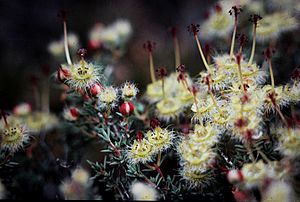Verticordia penicillaris facts for kids
Quick facts for kids Verticordia penicillaris |
|
|---|---|
 |
|
| Verticordia penicillaris in the Howatharra Nature Reserve near Geraldton | |
| Scientific classification | |
| Genus: |
Verticordia
|
| Species: |
penicillaris
|
Verticordia penicillaris is a beautiful flowering plant that belongs to the myrtle family, called Myrtaceae. This plant is special because it is found only in the south-west part of Western Australia. It's a small shrub that spreads out, often having many main branches. You can easily tell it apart from other plants in its group because of its bright yellow flowers. These flowers have cool white fringes and purple hairs on the tips of their long, thin parts called styles.
Contents
What Does Verticordia penicillaris Look Like?
Verticordia penicillaris is a spreading shrub that usually grows to be about 15 to 40 centimeters (6 to 16 inches) tall. It can spread out quite wide, sometimes up to 2 meters (6.5 feet) across! Sometimes, its lowest branches even grow roots into the soil, helping it spread even more.
Its leaves are shaped like narrow eggs and are slightly curved like a dish on the top. They are about 5 to 6 millimeters (0.2 inches) long and have a blunt, rounded end.
The Unique Flowers of Verticordia penicillaris
The flowers of this plant grow in groups that look a bit like flat-topped clusters at the ends of its branches. Each flower sits on a small stalk that is about 6 to 11 millimeters (0.2 to 0.4 inches) long. These flowers have a special smell that attracts animals.
The base of the flower, called the floral cup, is shaped like a top and is about 2 millimeters (0.08 inches) long. It has tiny hairs near its bottom. The sepals, which are like small leaves that protect the flower bud, are pale yellow and about 6 to 7 millimeters (0.2 to 0.3 inches) long. They have about five hairy white parts.
The petals are yellow and spread out. They are egg-shaped and about 3.0 to 3.5 millimeters (0.12 to 0.14 inches) long, with a fuzzy edge. The most interesting part might be the style, which is a long, thin part of the flower. It's about 15 to 19 millimeters (0.6 to 0.7 inches) long and can be straight or slightly curved. It has cool purple hairs near its tip, which is why the plant's name means "like a painter's brush"! This plant mainly blooms from September to October.
How Was Verticordia penicillaris Named?
The plant Verticordia penicillaris was first officially described in 1859 by a scientist named Ferdinand von Mueller. He studied a plant sample collected by Augustus Oldfield. Mueller published his description in a book called Fragmenta phytographiae Australiae.
The second part of its name, penicillaris, comes from a Latin word. It means "of a little tail" or "of a painter's brush." This name perfectly describes the brush-like tip of the flower's styles, which have those purple hairs.
In 1991, another scientist named Alex George reviewed all the plants in the Verticordia group. He placed Verticordia penicillaris into a smaller group called section Penicillaris, along with another plant called V. dasystylis.
Where Does Verticordia penicillaris Live?
This special Verticordia plant is found in a specific area of Western Australia. You can find it between the Kalbarri National Park, the Arrowsmith River, and Mullewa. It usually grows in shallow, sandy, or gritty soil, especially in places that get wet during the winter. These areas are part of what scientists call the Avon Wheatbelt and Geraldton Sandplains biogeographic regions.
Is Verticordia penicillaris Protected?
Yes, Verticordia penicillaris is considered a plant that needs protection. The Western Australian Government's Department of Parks and Wildlife has classified it as "Priority Four." This means it is rare or close to being threatened, so efforts are made to protect it and its habitat.
Can People Grow Verticordia penicillaris?
People who love gardening can grow this Verticordia plant. It's usually grown from cuttings, which are small pieces of the plant that are encouraged to grow roots. It grows well in gravelly or sandy soils. Once the plant is settled and growing strong, it can handle both frost (cold temperatures) and drought (very dry conditions). It has even been successfully grown in parts of eastern Australia that get summer rainfall.

